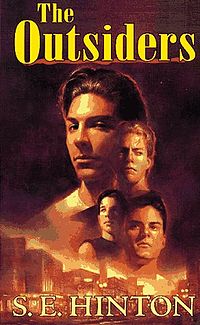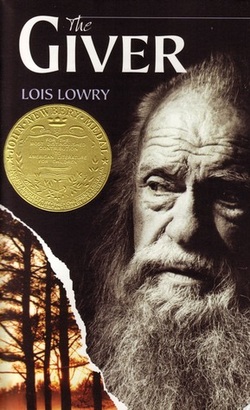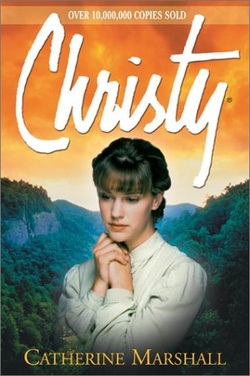
The Outsiders by S. E. Hinton
ISBN: 0-670-53257-6
Hinton, S. E. (2007). The Outsiders. New York: Viking Press.
Plot Summary
Ponyboy lives with his older brothers Darrel and Sodapop after the death of their parents. He is part of the Greasers, the poor students who find themselves up against the Socs, the popular students. While at a movie theater, Ponyboy meets Cherry and Marcia, two Socs, and walks them home. Their Socs boyfriends are upset and begin a fight with Ponyboy and his friends. The girls calm down the boys and the Greasers are able to get away. Ponyboy’s oldest brother Darrel is upset Ponyboy is home late and hits him, so Ponyboy runs away. While walking around town he meets up with Johnny, a friend. They wander around, but some Socs find them and nearly drown Ponyboy. Johnny gets scared and ends up stabbing and killing one of the Socs. They run to another Greaser who gives them money and hides them in an abandoned building. Johnny decides to turn himself in to the police after he hears a turf war has started. As they begin to leave, the building catches on fire with children inside. Ponyboy and Johnny run inside to save them, and timber falls on Johnny.
Critical Evaluation
What more can be written about a 46-year-old book that still resonates with contemporary teen readers? Written by a teen in the 1960’s, The Outsiders delves into universal themes that adolescents’ experience – loss, isolation, bullying, and other physical and emotional challenges. It is not only the themes but the characters that readers have responded to and identified with for generations. Though a short book, the characters are instantly real and create a sense of familiarity. No happy ending is possible with the turn of events, but the wish and hope remains. The teenage years are tough, and Hinton make sure everyone remembers. The orphaned family of three males are almost stereotypical – Darry, the oldest, responsible one; Soda, the middle easy-going, irresponsible one; and Ponyboy, the youngest who holds the most promise to break from the neighborhood. The tight-knit family and their friends that barely survive are damaged by an unfair world. Entering their world and their lives will break your heart. That is why The Outsiders, one of the first realistic novels written for young adults, is a modern classic that unifies teens and anyone that was once a teen.
Reader’s Annotation
The classic story of the haves and have-nots, their altercations with each other, and the consequences for all. Written when the author was a teenager herself.
About the Author
After writing The Outsiders as a teenager, S.E. Hinton experienced sudden fame and publicity. Her second novel is considered to be more thought-out, and Hinton has said she was careful to write each sentence. Four years later she published Rumble Fish, which had grown from an earlier short story. It was received with mixed reviews, some praising, some saying Hinton would never write again. Several years later she proved critics wrong and published again. In 1995, after seven years of no books, Hinton released a book for young children in kindergarten. A couple years later Hinton wrote The Puppy Sister, a fantasy written for elementary children.
S.E. Hinton born Susan Eloise Hinton in Tulsa, Oklahoma. She enjoyed reading, but disliked the lack of young adult novels available. This inspired her to write The Outsiders, her first novel. After writing The Outsiders, Hinton was quickly famous, which led to three years of writer’s block. Hinton enjoys horseback riding, reading, and auditing classes at the university nearby. She still writes longhand and then types her work onto a computer. Hinton lives with her husband and they have a grown son.
Genre
Realistic Fiction/Classic
Curriculum Ties
Social Issues/Bullying
Booktalking
The Haves and the Have-Nots, has anything changed in 40 years?
Reading Level/Interest Level
RL: 5th grade
IL: 7th grade and up
Challenge Issues
Possible challenge issues include teenagers engaging in illegal activities, such as gangs and murder.
In my defense file, I would include the following:
1) Library Mission Statement
2) Library Selection Policy approved by any or all of the following individuals—principal, school board, district librarian OR library manager, city council, mayor.
3) Library Bill of Rights adapted from CSLA Bill of Rights, AASL Bill of Rights and/or ALA Bill of Rights
4) Reviews, both positive and critical, from respected sources such as School Library Journal, VOYA, Booklist
5) Rationale for book inclusion for titles anticipated to be controversial, frequently challenged, or created when a book is challenged including: summary, audience, purpose, controversial issues and how they are handled
6) How the book fits within Common Core Standards or State Standards
7) Reconsideration form for challenger to complete—include a section asking which part was of particular concern, if the entire book was read, and what other similar titles are suggested instead
8) Student reviews from those who have read the book and either enjoyed or disliked the book and why.
Why Included
Even though it has a lower reading level, The Outsiders has become a modern classic of young adult literature, and speaks to readers of all ages.
Others in the Series
That Was Then, This Was Now (companion novel)
References
Hinton, S. E. (n.d.). Biography. Retrieved from http://www.sehinton.com/bio.html
ISBN: 0-670-53257-6
Hinton, S. E. (2007). The Outsiders. New York: Viking Press.
Plot Summary
Ponyboy lives with his older brothers Darrel and Sodapop after the death of their parents. He is part of the Greasers, the poor students who find themselves up against the Socs, the popular students. While at a movie theater, Ponyboy meets Cherry and Marcia, two Socs, and walks them home. Their Socs boyfriends are upset and begin a fight with Ponyboy and his friends. The girls calm down the boys and the Greasers are able to get away. Ponyboy’s oldest brother Darrel is upset Ponyboy is home late and hits him, so Ponyboy runs away. While walking around town he meets up with Johnny, a friend. They wander around, but some Socs find them and nearly drown Ponyboy. Johnny gets scared and ends up stabbing and killing one of the Socs. They run to another Greaser who gives them money and hides them in an abandoned building. Johnny decides to turn himself in to the police after he hears a turf war has started. As they begin to leave, the building catches on fire with children inside. Ponyboy and Johnny run inside to save them, and timber falls on Johnny.
Critical Evaluation
What more can be written about a 46-year-old book that still resonates with contemporary teen readers? Written by a teen in the 1960’s, The Outsiders delves into universal themes that adolescents’ experience – loss, isolation, bullying, and other physical and emotional challenges. It is not only the themes but the characters that readers have responded to and identified with for generations. Though a short book, the characters are instantly real and create a sense of familiarity. No happy ending is possible with the turn of events, but the wish and hope remains. The teenage years are tough, and Hinton make sure everyone remembers. The orphaned family of three males are almost stereotypical – Darry, the oldest, responsible one; Soda, the middle easy-going, irresponsible one; and Ponyboy, the youngest who holds the most promise to break from the neighborhood. The tight-knit family and their friends that barely survive are damaged by an unfair world. Entering their world and their lives will break your heart. That is why The Outsiders, one of the first realistic novels written for young adults, is a modern classic that unifies teens and anyone that was once a teen.
Reader’s Annotation
The classic story of the haves and have-nots, their altercations with each other, and the consequences for all. Written when the author was a teenager herself.
About the Author
After writing The Outsiders as a teenager, S.E. Hinton experienced sudden fame and publicity. Her second novel is considered to be more thought-out, and Hinton has said she was careful to write each sentence. Four years later she published Rumble Fish, which had grown from an earlier short story. It was received with mixed reviews, some praising, some saying Hinton would never write again. Several years later she proved critics wrong and published again. In 1995, after seven years of no books, Hinton released a book for young children in kindergarten. A couple years later Hinton wrote The Puppy Sister, a fantasy written for elementary children.
S.E. Hinton born Susan Eloise Hinton in Tulsa, Oklahoma. She enjoyed reading, but disliked the lack of young adult novels available. This inspired her to write The Outsiders, her first novel. After writing The Outsiders, Hinton was quickly famous, which led to three years of writer’s block. Hinton enjoys horseback riding, reading, and auditing classes at the university nearby. She still writes longhand and then types her work onto a computer. Hinton lives with her husband and they have a grown son.
Genre
Realistic Fiction/Classic
Curriculum Ties
Social Issues/Bullying
Booktalking
The Haves and the Have-Nots, has anything changed in 40 years?
Reading Level/Interest Level
RL: 5th grade
IL: 7th grade and up
Challenge Issues
Possible challenge issues include teenagers engaging in illegal activities, such as gangs and murder.
In my defense file, I would include the following:
1) Library Mission Statement
2) Library Selection Policy approved by any or all of the following individuals—principal, school board, district librarian OR library manager, city council, mayor.
3) Library Bill of Rights adapted from CSLA Bill of Rights, AASL Bill of Rights and/or ALA Bill of Rights
4) Reviews, both positive and critical, from respected sources such as School Library Journal, VOYA, Booklist
5) Rationale for book inclusion for titles anticipated to be controversial, frequently challenged, or created when a book is challenged including: summary, audience, purpose, controversial issues and how they are handled
6) How the book fits within Common Core Standards or State Standards
7) Reconsideration form for challenger to complete—include a section asking which part was of particular concern, if the entire book was read, and what other similar titles are suggested instead
8) Student reviews from those who have read the book and either enjoyed or disliked the book and why.
Why Included
Even though it has a lower reading level, The Outsiders has become a modern classic of young adult literature, and speaks to readers of all ages.
Others in the Series
That Was Then, This Was Now (companion novel)
References
Hinton, S. E. (n.d.). Biography. Retrieved from http://www.sehinton.com/bio.html


 RSS Feed
RSS Feed